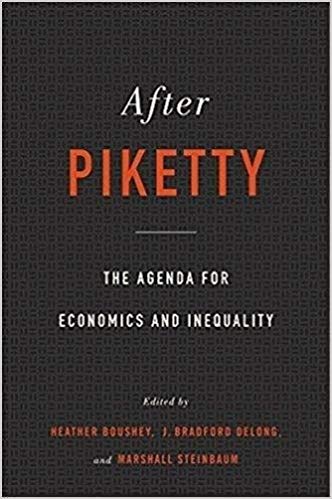Richard Godden: “After Piketty”, edited by Heather Boushey et al.

Thomas Piketty’s Capital in The Twenty-First Century, published in 2013 (English edition, 2014), is the economics equivalent of Stephen Hawking’s A Brief History of Time: it is a technical book that has secured mass sales, over two and a quarter million copies having been sold worldwide. One may wonder how many of the purchasers have read and properly understood it but there is no doubt that it has achieved almost cult status among those on the left of the political spectrum.
Its reception amongst economists has been mixed with divisions along predictable lines. Few, however, deny that its arguments, and the wealth of data underlying them, require critical evaluation and After Piketty, edited by Heather Boushey, J. Bradford DeLong and Marshall Steinbaum, is a significant academic contribution to this process. It focusses on the issue of economic inequality and comprises 21 essays framed by an introduction from the editors and a response to the essays from Piketty himself. Most of the contributors are economists, although some come from other disciplines (e.g. Daina Ramey Berry is Professor of History and African Diaspora Studies at the University of Texas and Gareth Jones is Professor of Urban Geography at the London School of Economics).
It is not a book to be read quickly and non-economists will find some parts heavy going, especially those littered with mathematical formulae. However, most of the book is accessible to any intelligent reader and, since Piketty’s key arguments are clearly set out, a prior knowledge of these arguments is not essential.
Most of the contributors are left-leaning and share significant parts of Piketty’s political outlook and the editors pin their colours to the mast in their introduction: they ask whether Piketty’s arguments are right or, at least, if they are not definitely right, whether his “disturbing scenario” is plausible and state that “the answer strongly appears to us to be: yes” (page 9). However, the book as a whole is by no means uncritical of Piketty. In fact, parts of it attack the foundations of his arguments and leave his edifice tottering.
Some of the essays are poor. In particular, a few descend into tedious left-wing rants (e.g. the section of Suresh Naidu’s essay entitled “Spheres of Wealth-Dictated Injustice”) and a number contain flashes of imprecise polemic, of which the reference to “proto-fascist populism” in the editors’ introduction is the first example (page 4).
Sadly, the essays of two of the editors (Heather Boushey and Marshall Steinbaum) are among the weakest in the book: Heather Boushey’s “A Feminist Interpretation of Patrimonial Capitalism” contains a few important points but ultimately adds little to the debate whilst Marshall Steinbaum’s “Inequality and the Rise of Social Democracy: an Ideological History” comprises a whistle-stop 30 page economic history of the USA, UK, France and Germany which is packed with contentious and unsupported assertions (of which perhaps the most extraordinary is the statement that the American entry into the First World War “had the flavour of a fanciful, elite foreign adventure”, page 448) and simple factual inaccuracies (such as the assertion that the UK government ministers during the Second World War “were for the most part the Labourites who had long advocated for a planned economy”, page 456). Gareth Jones’s essay (subtitled “Inequality, Political Economy, and Space”) is likewise short on careful logic and long on aggressive attacks on standard left-wing targets.
Parts of the book focus on issues that most people would regard as peripheral to its main subject (e.g. the two chapters that focus on historic – not modern – slavery) and there are a number of points that are assumed rather than argued (e.g. the Fabian sounding belief, expressed by several of the authors, that education is a key to overcoming the equality gap, which needs to be examined in the light of the growing evidence of the existence in a number of countries of a significant number of university educated people who are unable to secure anything other than low paid jobs). Furthermore, there are significant omissions. In particular, despite the commendable desire of the editors to integrate economics and other social sciences, there is no discussion of the impact of the conclusions and policy prescriptions on individual freedom, an omission that is most notable in David Singh Grewal’s essay, “The Legal Constitution of Capitalism”, which chillingly attacks the rule of law on the basis that it upholds capitalism.
These failings unquestionably mar the book but it remains well worth reading. It contains a number of high quality essays and much that should be thought provoking for all readers, whatever their political persuasions. The high points include Devesh Raval’s essay critiquing Piketty’s model, Eric Nielsen’s essay on human capital and wealth, Laura Tyson and Michael Spence’s essay on the effects of technology on income and wealth inequality and Mark Zandi’s essay on the macro-economic implications of rising inequality. Christoph Lakner’s essay regarding the global perspective is also an important correction corrective to the unduly western (or US) perspectives of some of the other essays.
Devesh Raval attacks Piketty’s famous assertion that inequality will continue to rise because r > g (the rate of return on capital is greater than the rate of economic growth). He points out that Piketty’s estimates of the elasticity of capital-labour substitution are out of line with the available literature and suggests that, in fact, capital and labour are not substitutable enough to sustain Piketty’s argument. He goes on to put forward two other explanations for the rise in the capital share of the economy: globalisation and labour saving technical change. These themes are then developed in subsequent essays, notably by Tyson and Spence and by Lakner. The conclusion of the former is that, “Inequality in market-based wealth and incomes is likely to increase over the next several decades, not because of features inherent in the capitalist system, but because of the effects of the digital revolution …” (page 203).
Neilsen questions Piketty’s focus on capital as the market value of tradeable goods. He cogently argues that “the omission of human capital is a serious weakness for both the data and the theory presented by Piketty” (page 151). In particular, he points out that inherited endowments include not merely the financial endowments considered by Piketty but also “social networks, cultural attitudes, and much else” (page 165). He rightly suggests that the inclusion in human capital in the mix is likely to result in policy proposals dramatically different from those put forward by Piketty. Indeed, he is bold enough to point out that, “A possible effect of Piketty’s plan … would be the immiseration of everyone to achieve a reduction in inequality”.
Some of the other contributors are likewise willing to draw conclusions that are unlikely to be welcome to many of Piketty’s supporters. In particular, coming from a global perspective, Lakner asserts that “The available evidence suggests that the Gini index of the global distribution of income has fallen for the first time since the Industrial Revolution, a development that is likely to continue” (page 261) and Zandi suggests that the “hand wringing over the prospects of a further erosion in income and wealth inequality the implications for the economy’s performance”, although reasonable, is likely to be misplaced since “prospects are good that inequality has peaked” (pages 406/7).
Such comments and conclusions demonstrate that, taken as a whole, After Piketty is by no means a simple contribution to the left wing scriptures: it is a serious exploration of the issues raised by Piketty. In fact, perhaps its most valuable contribution to the ongoing debate about inequality is the honest admission in a number of the essays that, despite the wealth of data that is now available and despite Piketty’s analysis, there remains much that we don’t know or don’t understand. Zandi points to numerous methodological and modelling problems that limit our understanding and several of the other authors point to deficiencies in the available data. The result is that, as Mariacristina De Nardi, Giulio Fella and Fang Yang point out in their essay, “Macro Economic Models of Wealth Inequality”, the mechanisms that cause both overall wealth inequality and individual outcomes within that distribution of wealth remain uncertain. Zandi thus wisely concludes, “Macro-economists should … not be comfortable that they have a good grip on what inequality means for our economic prospects” (page 411).
“After Piketty”, edited by Heather Boushey, J. Bradford DeLong and Marshall Steinbaum, was published in 2017 by Harvard University Press (ISBN 9780674504776). 565pp, plus notes.
Richard Godden is a Lawyer and has been a Partner with Linklaters for over 25 years during which time he has advised on a wide range of transactions and issues in various parts of the world.
Richard’s experience includes his time as Secretary at the UK Takeover Panel and a secondment to Linklaters’ Hong Kong office. He also served as Global Head of Client Sectors, responsible for Linklaters’ industry sector groups, and was a member of the Global Executive Committee.

